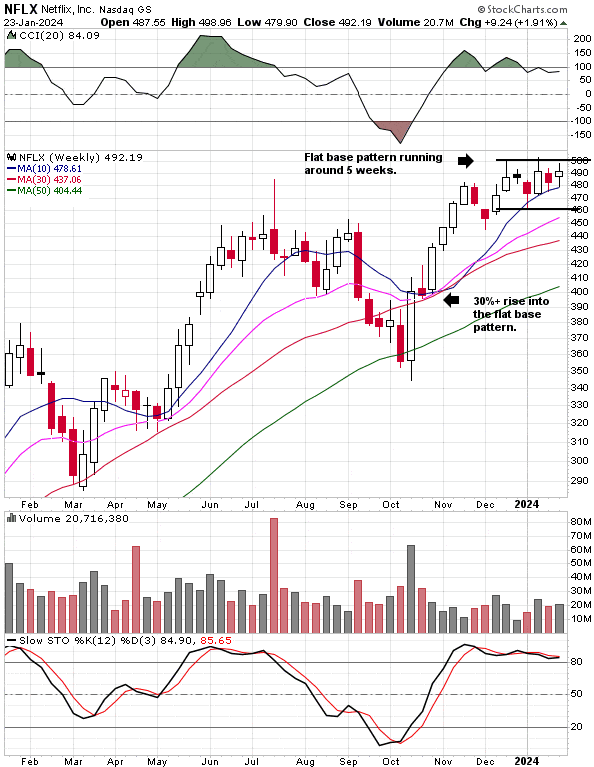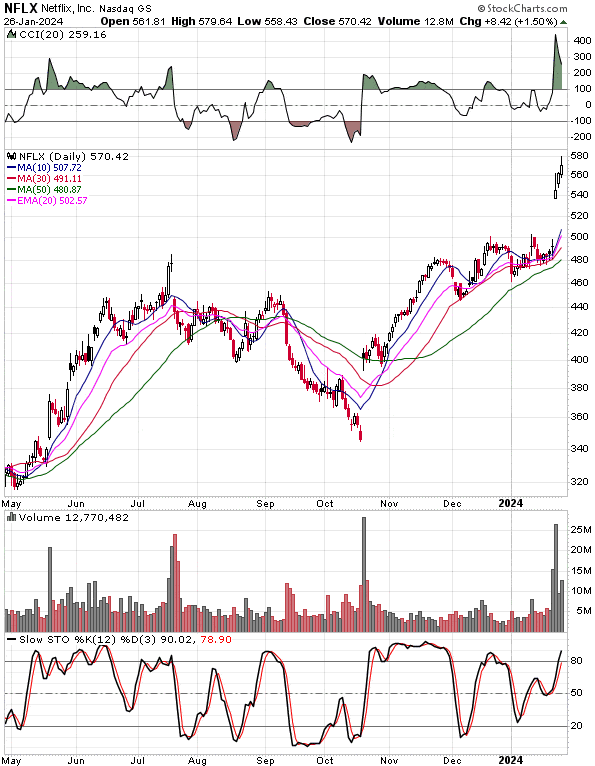A Big Flat Base Pattern and Breakout
The flat base pattern is one of the more bullish chart patterns on great stocks. Last week we just captured a couple more winners by identifying this fairly common chart pattern.
One of these stocks is an old favorite – NFLX. A stock that now has rapid cash flow growth, earnings growth and more reasonable valuation as they come out victorious from a 4 year streaming war with Disney and others.
What is a Flat Base Chart Pattern
The term can be used pretty loosely and encompasses both intraday, multi-day and weekly chart consolidations.
On an intraday basis, its a strong move higher followed by a half hour or longer consolidation on a five minute chart. It has a flat appearance as the narrow consolidation is carved out during the day.
These can also appear on a 30 minute chart on a stock that is making a big move over a few days or more. Again, the better ones have 5 half hour periods of narrow sideways action. The following article goes over the difference between flat top breakouts and flat base patterns.
The better timeframe for swing traders is on a weekly and daily chart where we will be spending most of our time in this blog post and video below.
Its important to understand that the longer timeframes tend to have the largest eventual moves in a stock. So a flat base breakout on a weekly chart will tend to run much further than the same pattern on a half hour or 5 minute chart during the day.
For swing trading, the flat base pattern is a 5 week or more sideways, narrow consolidation within a longer-term uptrend. So its really a form of a flag pattern where the uptrend leading into the 5 week consolidation is not as strong as a high tight flag.
There are also bottoming flat base patterns not covered here and usually take longer to develop and tend to be more volatile. Leading stocks, like NVDA, often move several hundred percent from flat base patterns near highs. These tend to be the biggest winners – not stocks near lows during a bull market.
Here’s an example of a flat base on NFLX that we featured last week to customers just before a big breakout. This is the weekly chart the night we featured it:

Charts courtesy of StockCharts.com
Why Does the Stock Flatline?
The stock moves sideways after a 30% or more runup because the buyers are taking a pause – often ahead of more news. Stocks like NFLX are being bought by many funds that are purchasing the stock continuously over time. Low priced stocks tend to be pumped and dumped while these top growth stocks tend to be in a long-term uptrend if earnings and sales are still growing which is key.
If the big buyers sense the stock may start to run away from them, they may want to just gradually buy shares to not overwhelm the market and send shares skyward. At least not for now as they accumulate their position.
In a lot of flat base patterns, you often see a final dip below the flat base consolidation ahead of a breakout. This shakes out some more of the weak hands before the runup.
The key in this situation is to look for a strong rebound developing within a few days after the final shakeout. Then we want to see the price rising quickly to the breakout point. This is similar to a Wykoff chain and spring – just on a different timeframe in this case.
What is a Flat Base Buy Point?
The entry point is a move above the high in the pattern. We usually want to see a fresh catalyst, a strong gap higher and then a break of the pre-market high as an entry signal. This is what we saw last week with NFLX where we entered the trade.
Ideally, we want to see the price breaking the high in the flat base pattern after the open the next trading session after the catalyst. Not gapping well above it. Similar to what we saw with SMCI last week out of its more bullish ascending base pattern.
NFLX reached that first 5% to 15% profit zone quickly after entering the trade where we take some profits, raised our stop and ensure we profit on the trade in an extended market. Commissions are free.

Charts courtesy of StockCharts.com
Now we can let it run for as long as the bull market continues while almost guaranteeing a profit since we took some profits and raised our stop. Sometimes top growth stocks will run 50% or more out of this pattern over the next year. This could happen in the soft landing scenario.
Where is the Stop-loss Point?
This depends on how long you want to hold it. When going for a say 7% move over a few days, you can use a 4% stop. If you are going for 20% or more over the next several weeks or so than a 10% stop may be just right.
We like around a 1.5/1 reward to risk ratio or better. Again, the biggest winners tend to hold a very tight stop-loss around these ideal technical entry points. We do not want to get in more than 1.5% above the technical entry point in most cases.
We can put our stop for a longer-term swing trade a little below the flat base consolidation if that is around 10% below the entry point. In this case, the price is gapping well above the technical entry point so we could put one in about 9% below the entry point and go for at least 15% for a longer-term swing trade.
This target is within the typical 15% to 25% move top growth stocks make out of these bullish consolidation patterns.
How Do You Find More Flat Base Patterns?
Its a good time to ask this question as earnings season is when you see the biggest moves out of these patterns. We just traded another on BAH on Friday. URI broke out of this pattern last week with a big earnings catalyst as well.
Its best to find a list of top growth stocks first. Companies with 25% or better average earnings and sales growth over the past few years with a return on equity of at least 15%. Outside of those, I would want to see a very narrow, “tight” consolidation within a strong uptrend that is long enough. 10 weeks or more is even better unless the growth is outstanding.
We find these patterns during the year in our swing trading alert service for customers. Its a pattern best traded in a bull market. Weaker markets generally call for a big catalyst at the point of entry and about a 60% lower price target with a tighter stop-loss as well.
Big Flat Base Breakouts Today
In the last blog post, we covered the long flat base breakout on NVDA that we caught for subscribers of our alert service just a few weeks ago.
Another one occurred on META that we featured to customers early in 2023. The video below goes over another flat base breakout on META a few years back and is another good example of what to look for.
After More Than 10 Thousand Trades over 15 Years, These 3 Strategies Ranked Best
More on the flat base and flat top breakout pattern
Learn Our Favorite Ranking Strategy for Stocks




